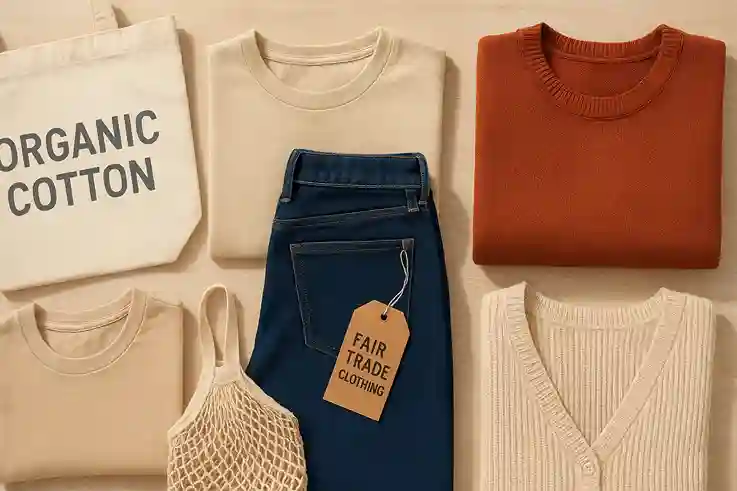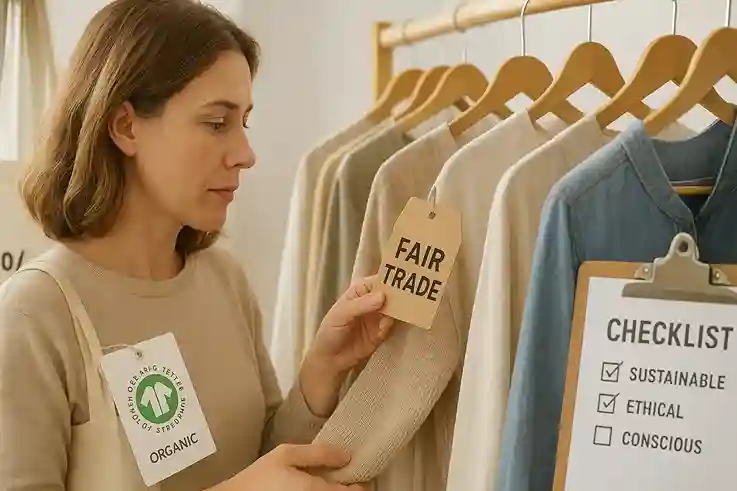What Is Ethical Fashion? It’s more than just clothes—it’s a choice that affects people, the planet, and how you feel every day. Ethical fashion focuses on sustainable fashion, fair trade clothing, and eco-friendly clothing. It’s about wearing pieces that do good while looking good.
Every outfit you choose can make a difference. From protecting workers’ rights to reducing environmental harm, ethical fashion creates a ripple effect that touches lives far beyond your wardrobe. Choosing slow fashion and practicing conscious shopping helps you feel proud, confident, and connected to a bigger purpose.
In this guide, you’ll learn exactly what ethical fashion means, how it impacts the world, and practical ways to embrace it in your daily life. Whether you’re new to the concept or ready to make smarter choices, this blog will show you how to dress with intention—and truly feel better inside and out.
What Is Ethical Fashion
So, what is ethical fashion? At its core, ethical fashion means choosing clothes that are made responsibly. It considers people, the planet, and the process behind every garment. Ethical fashion often overlaps with sustainable fashion. This means materials and production methods that reduce harm to the environment. Organic fabrics, recycled fibers, and low-waste manufacturing are common examples.
It also includes eco-friendly clothing. These items are designed to minimize pollution, use less water, and avoid harmful chemicals. The goal is to leave a smaller footprint while still looking stylish. Simply put, ethical fashion is about mindful choices. It’s choosing brands and clothing that respect workers, the environment, and your own values. Every purchase becomes a way to support fairness, sustainability, and quality over quantity.
The Core Principles of Ethical Fashion

1. Fair Labor Practices
Ethical fashion begins with people. Fair labor practices make sure workers are paid fairly for their skills and effort. They also guarantee safe and healthy working conditions. This protects workers from exploitation and harmful environments. Supporting fair trade clothing means choosing brands that value human rights. It ensures dignity, fairness, and respect for everyone involved in making your clothes. When you buy ethically, you directly support communities and help create a more just fashion industry.
2. Eco-Conscious Materials
The materials used in clothing make a big difference. Ethical brands focus on eco-friendly clothing made from sustainable sources. This includes organic cotton, recycled fabrics, and natural or low-impact dyes. Such materials reduce water usage, limit harmful chemicals, and lower pollution. By choosing these fabrics, ethical fashion helps conserve natural resources and protects the planet. Every garment becomes a step toward a cleaner, greener, and more responsible fashion industry.
3. Slow Production Cycles
Ethical fashion avoids mass production. Slow fashion focuses on quality rather than quantity. It promotes carefully crafted garments that last longer and wear better over time. By reducing the constant churn of new trends, slow fashion cuts down waste and overconsumption. Every purchase becomes intentional, supporting thoughtful production and minimizing the environmental impact. Choosing slow fashion means valuing durability, sustainability, and mindful wardrobe choices.
4. Mindful Consumption
Buying ethically also means buying consciously. Conscious shopping is about making intentional choices rather than impulsive buys. Instead of following fast fashion trends, you select pieces that reflect your values and fit your lifestyle. This approach encourages fewer, higher-quality purchases that last longer. It reduces waste, supports ethical brands, and gives you a wardrobe that truly represents who you are. Conscious shopping transforms fashion from a habit into a mindful, empowering practice.
Key Principles and Practices of Ethical Fashion
| Principle/Practice | What It Means | Benefit |
|---|---|---|
| Fair Labor Practices | Workers are paid fairly and work safely | Supports human dignity and rights |
| Eco-Conscious Materials | Use sustainable fabrics and low-impact dyes | Reduces pollution and conserves resources |
| Slow Fashion | Focus on quality over quantity, durable garments | Reduces waste, promotes long-term value |
| Conscious Shopping | Thoughtful purchasing based on need and versatility | Minimizes impulse buying, environmental impact |
| Transparency & Local Support | Open brand practices and support for small/local brands | Encourages ethical industry standards |
Why Ethical Fashion Matters

1. Environmental Impact
Ethical fashion has a powerful effect on the planet. The production of conventional clothing creates a large carbon footprint, from energy-intensive manufacturing to long-distance shipping. By choosing eco-friendly clothing and embracing sustainable fashion practices, you help reduce this impact. Sustainable fabrics, like organic cotton or recycled materials, use less water and require fewer harmful chemicals. Thoughtful production methods also minimize waste and pollution, protecting rivers, soil, and air quality.
Every ethical choice, from buying slower to selecting eco-conscious brands, contributes to preserving natural resources. Over time, these small decisions add up, creating a cleaner, greener, and healthier planet for future generations.
2. Social Impact
Fashion isn’t just about clothes—it’s about the people who make them. Supporting fair trade clothing ensures workers receive fair wages and work in safe, respectful conditions. Many ethical brands go further by investing in local communities, funding education, healthcare, and better living standards. Your purchasing choices directly support these efforts, helping build stronger, more sustainable communities. Every ethical buy contributes to fairness, human dignity, and social equality across the globe. By choosing responsibly, you become part of a movement that values people as much as style.
3. Personal Impact
Choosing ethical fashion goes beyond style—it feels deeply rewarding. Knowing your clothes are made responsibly brings a sense of pride and confidence. By practicing conscious shopping and embracing slow fashion, you make intentional choices that reflect your values. Each purchase becomes more than clothing; it’s a statement of care for the planet and people.
This approach adds emotional satisfaction, making your wardrobe a source of empowerment. Every outfit you wear becomes a small but meaningful contribution to a better, fairer, and more sustainable world.
How to Identify Ethical Fashion

1. Look for Certifications
Certifications are a clear sign that a brand follows verified ethical standards. Labels like Fair Trade, GOTS (Global Organic Textile Standard), and B Corp confirm that workers are paid fairly and work in safe conditions. They also indicate that production methods are sustainable and environmentally responsible. Choosing certified clothing gives you confidence that your purchase supports both people and the planet. These labels make it easier to identify trustworthy brands in a world full of options.
2. Check Brand Transparency
Ethical brands are open about how their clothes are made. They share clear details on sourcing, production methods, and labor practices. This transparency reflects a true commitment to ethical values. When brands disclose their processes, it’s easier to trust that your purchase supports fairness and sustainability. Conversely, if a brand hides information about how it makes its clothing, it may not align with your principles. Being informed helps you make smarter, more responsible fashion choices.
3. Spot Sustainable and Eco-Friendly Indicators
Look for clothing made from eco-friendly fabrics such as organic cotton, recycled fibers, or low-impact dyes. These materials reduce harm to the environment by using less water, less energy, and fewer chemicals. Sustainable fashion focuses on minimizing pollution and conserving natural resources throughout the production process. You can often identify these items through labels, detailed material descriptions, or the brand’s storytelling. Paying attention to these indicators ensures your wardrobe supports both the planet and ethical practices.
How to Identify Ethical Fashion
| Method / Tip | What to Look For | Benefit |
|---|---|---|
| Certifications | Fair Trade, GOTS, B Corp | Verified ethical and sustainable practices |
| Brand Transparency | Production details, sourcing, labor practices | Ensures accountability and informed choices |
| Sustainable Fabrics | Organic cotton, recycled fibers, low-impact dyes | Reduces environmental impact |
| Conscious Shopping | Pause before buying, prioritize quality over quantity | Minimizes waste and promotes intentional wardrobe |
| Support Local / American-Made | Smaller, U.S.-based brands | Strengthens local communities and ethical practices |
4. Tips for Conscious Shopping
Ask Yourself Before You Buy
Practice conscious shopping by asking yourself if you truly need a piece. Take a moment to pause before purchasing and think about how it fits into your wardrobe. Does it serve a purpose, or is it just an impulse buy? This small step helps reduce unnecessary purchases, lowers waste, and encourages more mindful consumption. Over time, it trains you to shop responsibly and make choices that align with your values.
Prioritize Quality Over Quantity
Prioritize quality over quantity by choosing durable, well-made items instead of following every fast fashion trend. High-quality clothing lasts longer, maintaining its shape and appearance over time. This not only saves money but also reduces waste and the environmental impact of constantly replacing cheap garments. Investing in sturdy pieces supports slow fashion principles and ensures your wardrobe is both responsible and long-lasting.
Invest in Versatile Pieces
Invest in clothing that can be styled in multiple ways. Versatile pieces, such as neutral tops, classic jackets, or simple dresses, can be worn for different occasions. This approach ensures you get more use from each item, reducing the need for excessive purchases. By focusing on versatility, you naturally embrace slow fashion principles, building a wardrobe that is functional, sustainable, and aligned with your values.
Support Ethical and Local Brands
Support local or smaller brands that follow ethical and sustainable practices. These companies often prioritize fair labor, eco-friendly materials, and transparent production methods. By choosing their products, you help responsible businesses grow and thrive. Your support also sends a message to the wider fashion industry, encouraging more brands to adopt better standards. Every purchase becomes a way to promote fairness, sustainability, and conscious consumerism in fashion.
The Government Accountability Office (GAO) discusses federal actions and recommendations to reduce textile waste and advance textile recycling in the U.S.🔗 GAO Textile Waste Report
Benefits of Adopting Ethical Fashion

1. Positive Environmental Change
Choosing eco-friendly clothing and embracing sustainable fashion practices significantly reduces waste, pollution, and water consumption. Conventional clothing production often relies on large amounts of water and harmful chemicals. By opting for ethical alternatives, each purchase helps lower your wardrobe’s carbon footprint.
Over time, these mindful choices contribute to protecting forests, rivers, and other natural resources. Every ethical garment you buy supports a cleaner, greener, and more sustainable future for the planet.
2. Support for Ethical Labor
By choosing fair trade clothing, you directly support workers’ rights, fair wages, and safe working conditions. Many garment workers face long hours and unsafe environments in conventional fashion. Ethical fashion ensures that the people who make your clothes are treated with dignity, respect, and fairness. Your purchase becomes a meaningful action that empowers communities and helps create a more just and responsible fashion industry. Every ethical choice contributes to improving livelihoods and promoting equality for workers worldwide.
3. Quality Clothing and Slow Fashion Benefits
Adopting slow fashion means choosing durable, high-quality clothing over cheap, disposable items. These pieces are made to last, which reduces overconsumption and the constant need to replace garments. By investing in quality, you minimize the environmental impact of fast fashion, including waste, pollution, and resource depletion.
Your wardrobe becomes more intentional and practical, filled with items you truly value. Slow fashion not only supports sustainability but also encourages mindful shopping habits that benefit both you and the planet.
4. Emotional Rewards: Confidence and Pride
Wearing ethical fashion brings a deep sense of satisfaction and confidence. Knowing that your choices positively impact the planet and support fair labor adds meaningful value to every outfit. Each piece in your wardrobe becomes a symbol of responsibility, care, and conscious living.
This awareness creates pride in your style and reinforces the connection between your clothing and the greater good. Ethical fashion turns everyday dressing into a purposeful act, giving both your wardrobe and your mindset a positive, empowering boost.
Simple Ways to Start Practicing Ethical Fashion
Buy Fair Trade and Eco-Friendly Clothing
Start by choosing clothing certified as Fair Trade or crafted from eco-friendly fabrics. Fair Trade certification ensures that workers receive fair wages, work in safe conditions, and have access to community benefits. Eco-friendly fabrics, such as organic cotton, recycled fibers, and low-impact dyes, minimize environmental damage by reducing chemical use, water consumption, and pollution.
By selecting these garments, you directly support sustainable production methods while promoting social responsibility. Each purchase becomes a conscious choice that benefits both the planet and the people who make your clothes, reinforcing the connection between fashion and ethical living.
Embrace Slow Fashion
Focus on owning fewer, high-quality garments rather than constantly chasing fast-fashion trends. Slow fashion emphasizes durability, timeless design, and superior craftsmanship. Investing in well-made pieces means your clothing lasts longer, reducing the need to replace items frequently and minimizing waste.
This approach also encourages intentional wardrobe choices—each item is selected thoughtfully for style, function, and sustainability. Over time, your wardrobe becomes more cohesive, practical, and environmentally responsible, reflecting values of quality over quantity.
Support Local and Transparent Brands
Select American-made brands that openly share production details, from sourcing materials to labor practices. Transparency demonstrates a genuine commitment to ethical fashion and allows you to make informed choices. Supporting smaller, U.S.-based companies strengthens local communities and encourages the fashion industry to adopt responsible practices.
Many of these brands focus on fair trade clothing, eco-friendly fabrics, and slow fashion principles, proving that style and ethics can coexist. Every purchase you make sends a message that accountability, sustainability, and quality matter—while supporting American workers and businesses.
Make Conscious Shopping a Habit
Before buying, pause and ask yourself if you truly need the item. Consider how it fits into your existing wardrobe and whether it aligns with your values. Prioritize versatility and quality over quantity, choosing pieces that can be styled in multiple ways and last for years. Thoughtful, intentional purchases reduce impulse buying, minimize waste, and lower your wardrobe’s environmental impact.
By practicing conscious shopping consistently, you transform your wardrobe into a reflection of ethical fashion principles, combining style, sustainability, and social responsibility in every choice.
FAQs: What is Ethical Fashion
Conclusion on What Is Ethical Fashion?
Ethical fashion is more than a trend—it’s a way to make thoughtful choices that benefit people, the planet, and yourself. By embracing fair trade clothing, eco-friendly fabrics, slow fashion, and conscious shopping, you can create a wardrobe that reflects your values. Every intentional purchase reduces environmental impact, supports ethical labor, and brings emotional satisfaction.
Starting small—like choosing versatile, high-quality pieces or supporting American-made brands—can make a meaningful difference. Look good, feel even better, and wear your values proudly with every outfit. Ethical fashion isn’t just clothing; it’s a movement that empowers change, one garment at a time.
Start Your Ethical Fashion Journey
Choose one ethical piece today—support fair trade, eco-friendly fabrics, or slow fashion. Every choice counts for people, the planet, and your style.

Silvia Heart is a lifestyle and wellness writer with a background in apparel and a degree in fashion. She blends creativity with practical insights, guiding readers toward intentional, balanced living. Through her approachable style and thoughtful storytelling, Silvia inspires her community to embrace both everyday joy and personal growth.


